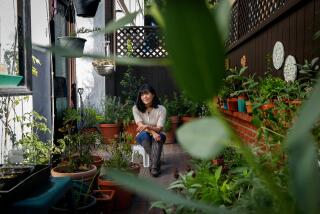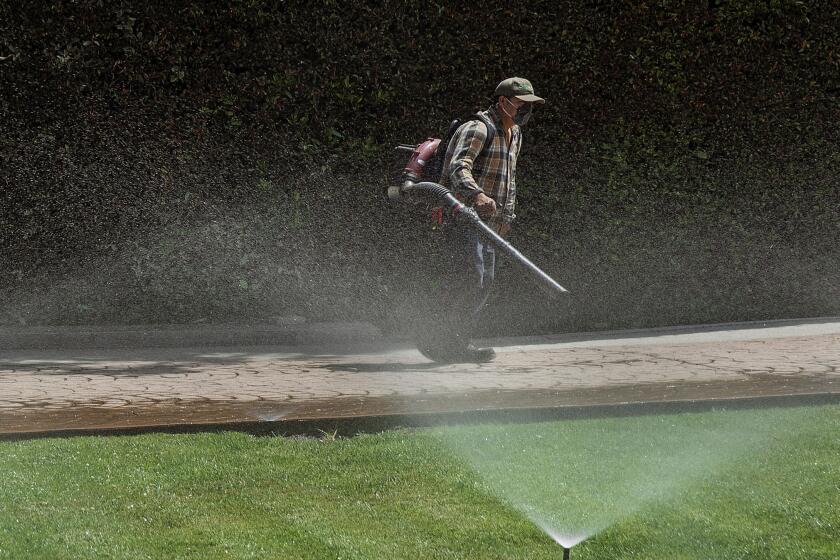Manure Is Safe to Use in Garden--to a Point
- Share via
QUESTION: I cannot get a straight answer from any nurseryman as to the value of composted steer manure as a mulch or a soil amendment. Aware of its high salt content, I have soaked it in a bottomless trash can before use, or rototilled it directly into the soil. Am I inviting eventual problems?
--J.L., Orange
ANSWER: You are right about the high salt content. According to soil scientist Garn Wallace, of Wallace Laboratories in El Segundo, on a salinity scale, one would be a good amount for the garden and 25 would be the amount found in steer manure--it is full of mineral salts, even common table salt (because of salt licks in the feed lots).
Leaching, by soaking or running water through it, removes the salts but it also removes the nitrogen, potassium and other nutrients. And you don’t want that salt-laden water to run into the garden. Mushroom compost, incidentally, contains leached steer manure and hay, among other things.
According to Wallace, you can safely use three cubic feet of steer manure--right out of the bag--per 100 square feet once or twice a year. In other words, you can spread a one-third inch layer on the soil, till it in and not worry about it. Rains and watering will carry the salts away. Any more is inviting problems.
Straight steer manure will add some organic matter to the soil and add potassium but little else. Wallace suggests mixing it with chicken manure, which is high in all-important nitrogen, or mixing it with a sewage sludge-based product (like Kellogg’s Nitrohumus) for a better mix of nutrients.
You can use steer manure as a thin mulch (as is commonly done over grass seed) or use small amounts for building a better soil. But homemade compost is a much better soil improver, especially if nutrient-rich grass clippings are added in the composting process.
Next best for improving soils, in his book, is alfalfa meal or alfalfa hay that you’ve ground into inch-long pieces by running a lawn mower over it. These work like a green manure and add texture and nutrients to the soil. Then come the bagged amendments commonly sold at nurseries; here, his favorite is a medium grade of peat moss.
The Older the Tree, the Sooner It Bears Fruit
Q: We would like to plant an orange, an apple, a pomegranate and a tangerine tree. We are pushing 70 years old and would like the trees to bear fruit as soon as possible. When is the best time to plant, and what about dwarf trees? Do they bear fruit sooner?
--E.S., Pomona
A: I think just about everyone wants fruit from their trees as soon as possible, and Bill Nelson, who runs Pacific Tree Farms, a fruit tree nursery in Chula Vista, says the only secret is to buy older trees.
A tree in a 15-gallon can is a year or so older than one in a 5-gallon can and should bear some fruit its first year. Of course, many citrus in 15-gallon cans are already covered with fruit, but this also works for apples and pomegranates, if you can find them this size.
Dwarf trees do not bear sooner; neither do semi-dwarfs. Semi-dwarfs are the best size, however, for most gardens and produce the best fruit. In the case of citrus, semi-dwarfs also have tastier fruit and the trees are a little more cold-hardy, thanks to the dwarfing rootstock to which they are grafted.
Right now is the best time to plant so the trees are established by summer. You may still find bare root deciduous fruit trees at nurseries, or look for container-grown trees.
Plant in soil with good drainage and water two or three times a week for the first six weeks (except during rains). Nelson suggests fertilizing at planting time and then once a year in late February or March with those big slow-release pellets (the 21-gram size, like those made by Best), buried about 4 inches deep along the drip line.
Don’t let anything grow under them, but keep 2 to 3 inches of composted mulch under the trees, being sure to keep the mulch at least a foot from the trunk.
For additional information on making sure your soil has good drainage and how to plant and care for trees, send a stamped, self-addressed envelope to Pacific Tree Farms, 4301 Lynwood Drive, Chula Vista, CA 91910. The nursery will send you a useful information sheet.
Bird of Paradise Needs Periodic Root Division
Q: I have been trying to find out how to prune my bird of paradise. It’s 20 years old and gets about 15 flowers a season, but when flowers die, they look ratty. Can they be cut off? And if so where? Near the top or the bottom?
--B.F., West Hills
A: Cut off the flowering stem as close to the ground as you can, as soon as it fades. The official city flower of Los Angeles, bird of paradise blooms better if regularly fertilized, though it can get by on next to no care.
When clumps get old and big (as many are in Los Angeles), they may need to be dug up and divided if blooming slows down. This is a huge job, and you won’t believe how many roots are under the plants.
But digging them out and splitting up the root ball with an old serrated knife or a very sharp spade--into chunks about a foot across--then replanting the best of these will dramatically rejuvenate old plants.
Bird of paradise also does well in large containers, so you can pot up the extra divisions and grow them on the patio.
*
Questions should be sent to “Garden Q&A;” in care of the Real Estate section, Los Angeles Times, Times Mirror Square, Los Angeles 90053. Please include your address and telephone number. Questions cannot be answered individually.






